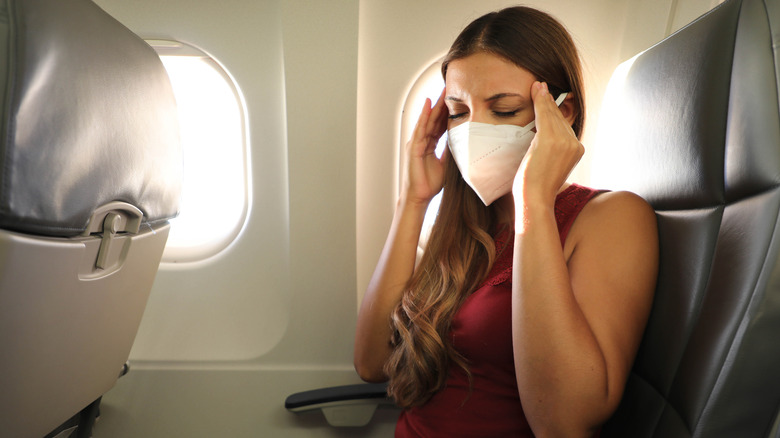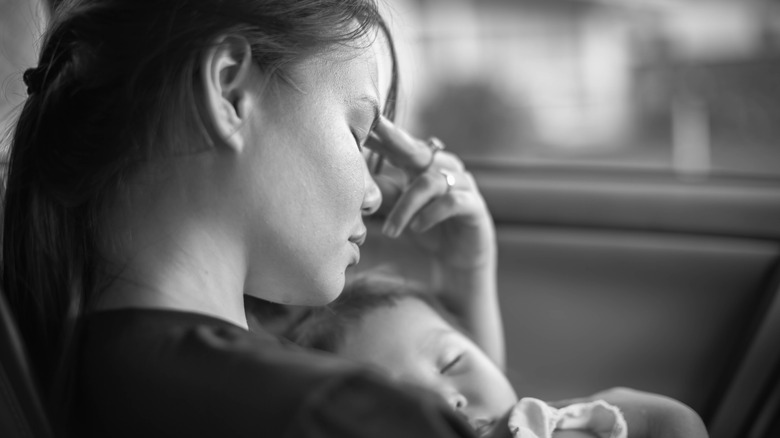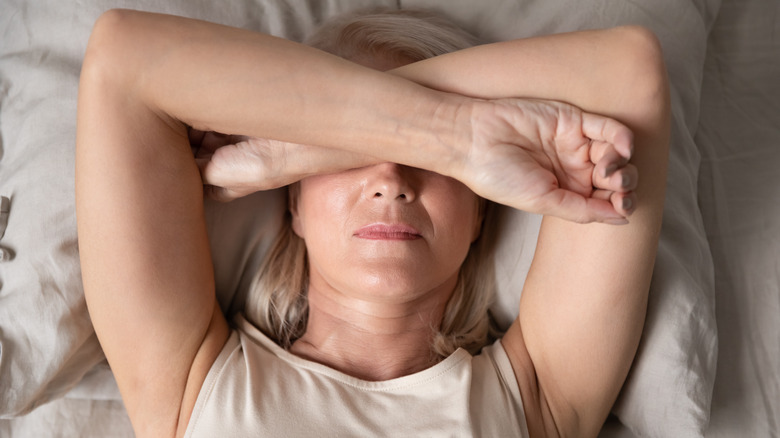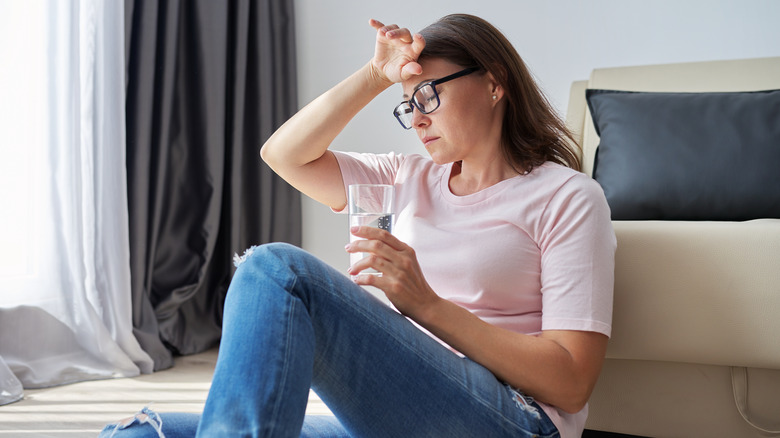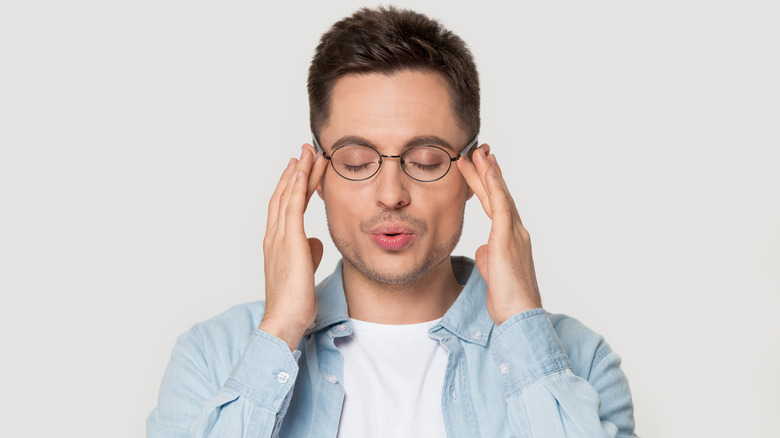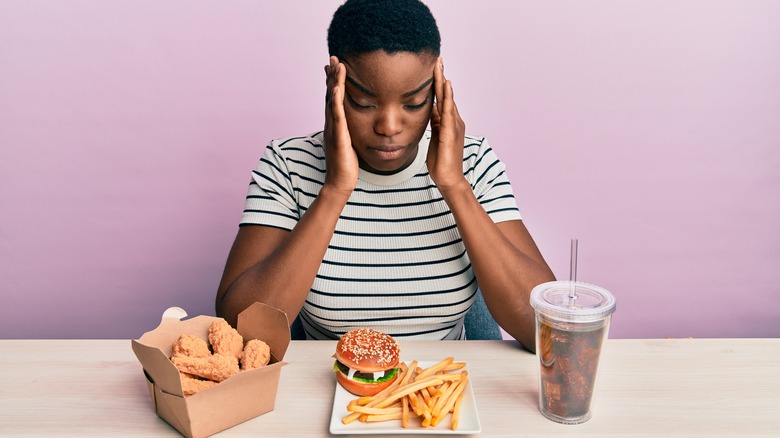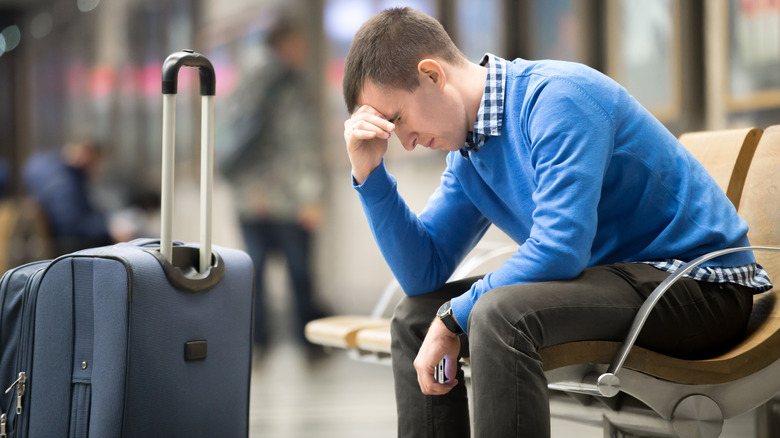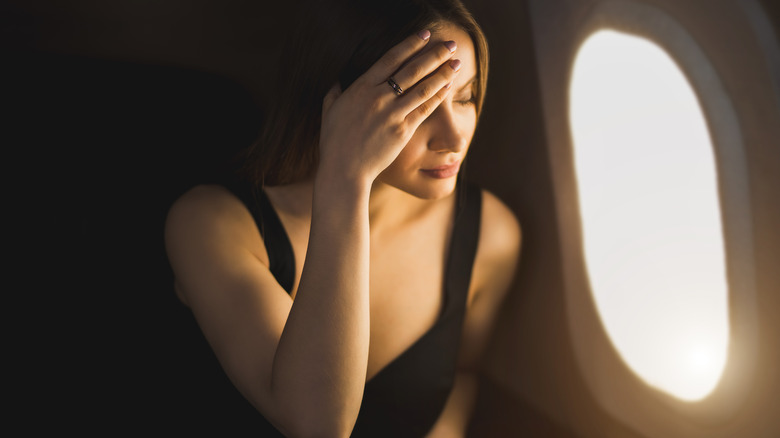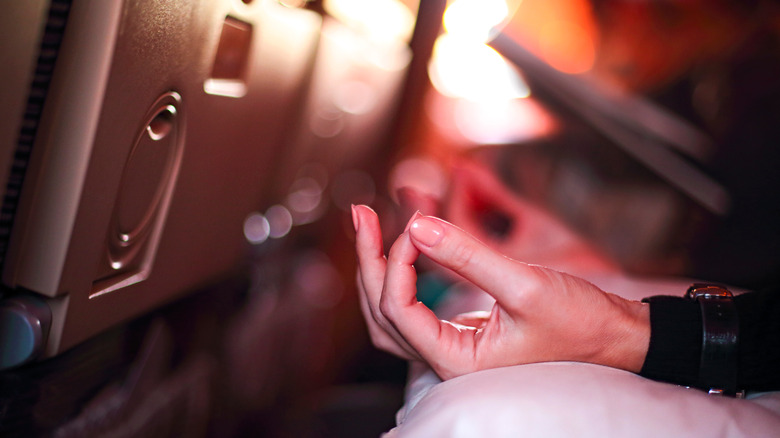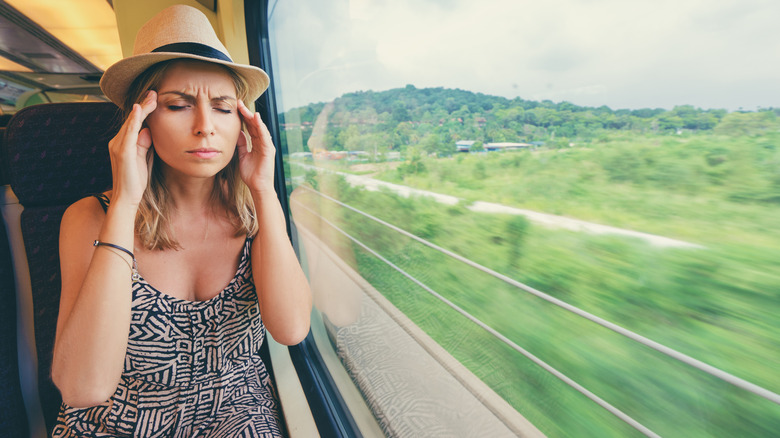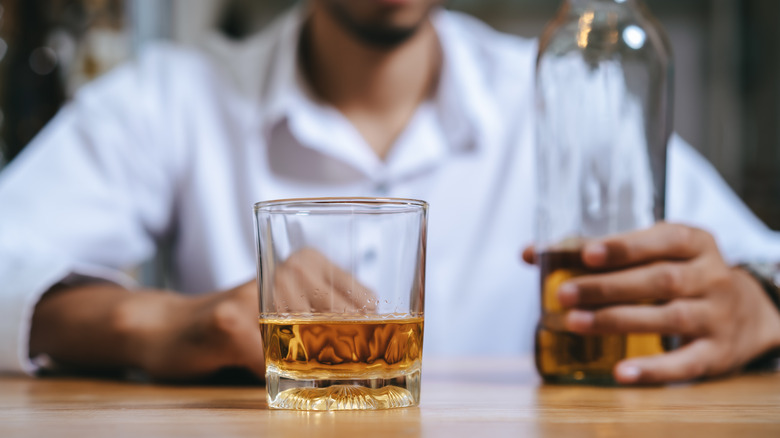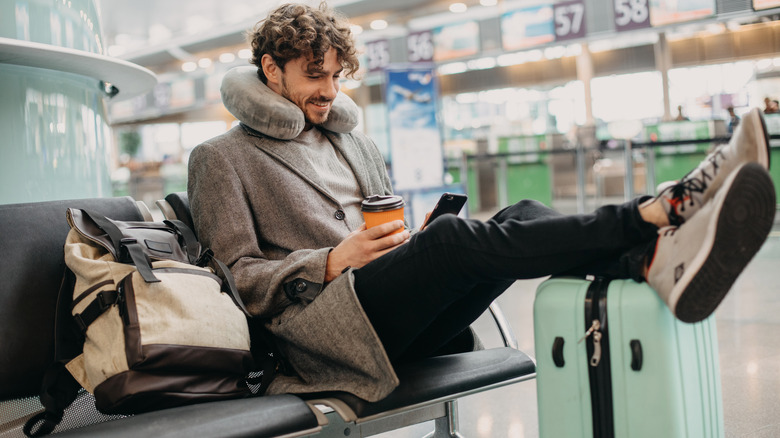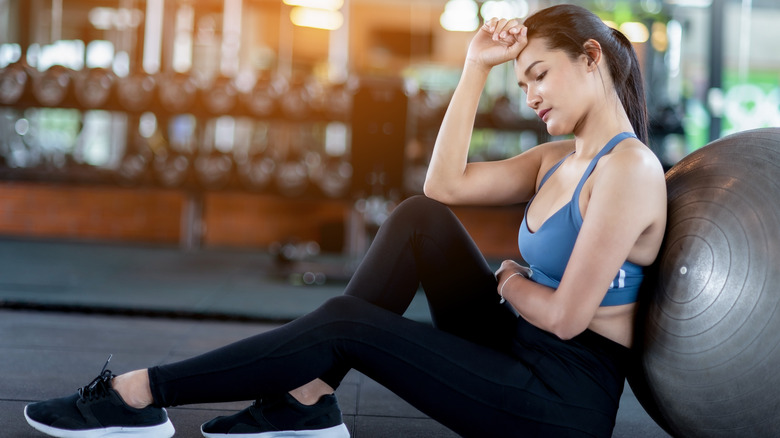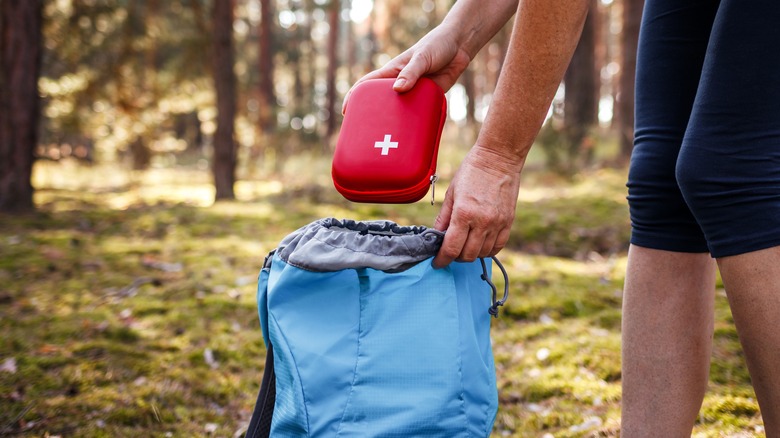How To Keep Migraines At Ease While Traveling
Migraines are a leading cause of disability worldwide, impacting both men and women (via The Journal of Headache and Pain). Migraine headaches usually manifest as a throbbing and pulsing pain that radiates throughout the head (via National Health Service). If that's not bad enough, they can also come along with a host of other symptoms like nausea, diarrhea, sweating, and increased sensitivity to light or sound.
It may seem as though they creep up out of nowhere. But for most people, there are certain factors that make a migraine more likely to occur, notes the National Institute of Neurological Disorders and Stroke (NINDS). Some people are provoked into a migraine attack by stress; others are sensitive to bright or flashing lights, while some individuals find themselves more vulnerable when they're lacking food or sleep.
There are numerous things that can trigger a migraine when you're traveling (via PLoS One). Each person is different, so it's important to be mindful of what sparks or exacerbates your episodes. Here are some simple ways to keep migraines at bay while you're on the road.
Plan ahead to avoid stress
Stress continues to be one of the most commonly-reported triggers for migraines. For instance, a review of research on stress and migraine noted one study of more than 1,200 migraine sufferers which found that 80% of participants cited stress as the number one perpetrator (via The Journal of Headache and Pain).
Research shows that people with chronic migraines generally experience higher levels of stress than others (via The Journal of Headache and Pain). They're also more likely to deal with depression, anxiety, sleep problems, and poor quality of life.
Although we can't always control the stressful events that come our way, we can think ahead and be prepared for some of them (via Independent Travel Cats). You might want to consider whether you'll be encountering large crowds and noisy environments, or going for long periods of time without food while traveling. Are there likely to be delays or lengthy queues? How could you avoid getting caught in hold-ups? Being aware of what to expect and having handy coping strategies under our belts can help us avoid and better manage stressors so that we don't feel overwhelmed. By anticipating unforeseen events, we can create an itinerary that works for us. It can be helpful to write a list of everything you'll need to feel less stressed out: Medications, documents, devices, creature comforts, etc.
Try to set a consistent sleep schedule
Traveling can mean that you're suddenly faced with a number of changes, including a new sleep schedule. For long-haul travelers, changing time zones can throw your body clock out of sync and interfere with your normal sleep-wake cycle (via Human Brain Mapping). Jet lag plays havoc with your body and brain in various ways: In particular, it lowers your melatonin and increases your thyroid hormone levels, which can lead to sleep woes.
According to a study from the journal Cephalalgia, almost 50% of people attributed their migraines to sleep problems. Having a lousy night's sleep can elevate your risk of a migraine. But migraine sufferers are also more likely to have poor quality of sleep than others, per Medscape, which can keep people stuck in a vicious cycle of insufficient sleep and migraines.
It's possible for both too much or too little sleep to trigger your migraine, reports the American Migraine Foundation. Therefore, getting the right amount of shuteye goes a long way. You can establish a regular sleep-wake schedule by practicing good sleep hygiene. A basic strategy is to avoid large meals in the hours leading up to bedtime. Going to bed and waking up at the same time each day can also help reset your natural circadian rhythm. And it's helpful to create an environment that encourages sleep, such as a dark and quiet room with no devices around that emit blue light, since they increase arousal.
Make sure that you're hydrated
People are more likely to get migraines when they don't drink enough water, according to research (via Current Pain and Headache Reports). Water deprivation can both trigger and prolong migraine attacks. One of the ways in which this happens is that a lack of fluid intake causes the blood vessels in the brain to tighten and constrict. This can put pressure on the pain-sensitive meninges surrounding the brain and vascular structures.
People who are dehydrated tend to report more severe, frequent, and longer-lasting migraine headaches than those who are properly hydrated, notes a 2020 study published in the Journal of Clinical Neuroscience. Even mild dehydration can give rise to a headache. A study from the journal Nutrition Reviews found that some people were relieved of their dehydration-induced migraines within just 30 minutes of knocking back fluids.
At a soaring altitude, air travel can be particularly dehydrating on your body (via Nutrients). Be sure to pound plenty of water before and during your journey to reach your recommended intake of two liters a day. You can also carry your own reusable water bottle with you, recommends The New York Times, to avoid buying single-use plastic bottles when you're on the go.
Give yourself a head massage
Headaches that occur during airplane travel, also termed "airplane headaches," are most common when taking off and landing (via The Journal of Headache and Pain). One of the purported causes of these types of headaches is a condition known as sinus or ear barotrauma. This is due to a change of cabin pressure, whereby the air pressure in your ear is suddenly different to the air pressure outside of your body (via Journal of the Belgian Society of Radiology). It can make your ears feel stuffy and blocked as well as causing some discomfort and pain. And while an airplane headache is different from a migraine — for one thing, these types of headaches typically resolve soon after the plane finishes ascending or descending rather than lasting for days — migraines may also be triggered by similar mechanisms (per MigraineAgain).
There are several effective strategies you can use to relieve pressure on your ears (via The Journal of Headache and Pain). For instance, you can yawn or chew gum. You can also equalize your ears using the Valsalva maneuver, which is a common technique that involves breathing out while keeping your nose and mouth closed (via YouTube).
You can also tackle migraines head-on by administering a self-massage (via The Journal of Headache and Pain). Some people find it soothing to rub or press on the temples, scalp, forehead, and neck with their fingers or an object. There are various types of self-massages that can help you reduce and usher away headache pain during flights (via MigraineAgain).
Eat the right foods and avoid migraine-triggering ones
There's evidence that certain foods can fuel the fire when it comes to migraines (via Nutrients). The commonly cited culprits include citrus fruits, chocolate, caffeine, alcohol, wheat, onions, and processed foods. Some foods may cause or heighten migraines upon withdrawal. It's suggested that certain ingredients also play a role in developing a migraine headache, like monosodium glutamate (MSG), histamine, tyramine, aspartame, and sucralose. Experts agree that people are sensitive to different things, so it's helpful to keep a diary and identify your specific dietary triggers.
People with chronic migraines can massively benefit from following a plant-based diet that's rich in dark leafy greens, according to a study published in BMJ Case Reports. It's believed that nutrient-dense foods, such as leafy vegetables, exert their therapeutic effects by reducing inflammation. These foods might even be more effective at lessening the frequency of migraine headaches than preventive and abortive migraine medications.
If you're prone to migraines, steer clear of migraine-triggering foods and drinks the day before you travel as well as during your journey. There are plenty of migraine-friendly foods you can take along with you to snack on, per MigraineAgain, including carrots, dark chocolate, and fresh fruits like bananas and figs.
Get ready for a change in weather or altitude
Some people who battle migraines are sensitive to certain weather conditions, according to research (via Annals of Clinical and Translational Neurology). They may find that heat, sunlight, or humidity can set off their headaches and make them feel worse when they occur. Moving from one climate to another in a short space of time can also set the stage for a migraine attack. Others tend to experience headaches when there's a drop in barometric pressure, which often means that a storm is on its way (via Cureus). Weather changes are said to underlie migraines by causing chemical imbalances in the brain, specifically a shift in serotonin levels.
Traveling to a high altitude can be particularly triggering for some migraineurs (via Pain). This is because the oxygen levels in the air suddenly fall, and people are breathing in fewer molecules of oxygen, per the American Migraine Foundation. There are a few different things that you can do to reduce your chances of a migraine attack at high altitudes, such as staying hydrated, resting and taking regular naps, and planning your trip with sufficient time for your body to adjust.
While you can't change the weather, you can arrive mentally and physically prepared to your new destination. Take some time to do a bit of research so that you know what to expect. If the sun tends to be a major migraine-trigger for you, make sure you pack sunglasses and breathable clothing (via GoodRx). Visit your doctor before you go and get hold of any necessary medications and supplies that you may need.
Pack items that can help neutralize environmental triggers
Unfortunately, there's a whole host of things on planes that could irritate or worsen your migraines, per MigraineAgain. Bright lights, loud noises, offensive odors, and cabin pressure. Although you may not be able to adjust or eliminate most of these factors, there are ways to make life easier for yourself.
There are certain items that you can pack or ask your airline for, which could make all the difference. These include an eye mask, earplugs, and noise-canceling earphones to shut out strong stimuli. Ice packs, medications, and supplements can help with migraine pain. Some people find that a peppermint or lavender stick helps ward off a headache or mask unwanted smells, which can be triggering. A pillow, blanket, or some of your favorite snacks may also bring some comfort and relief. It can be helpful to make a list of potential triggers that could aggravate your headaches so that you can prepare for some of them in advance by packing your carry-on bag with useful items.
Do some breathing exercises
Breathing exercises can wave off headaches by helping you relax and manage stress. Research shows that deep breathing and progressive muscle relaxation techniques are effective alternatives to migraine medications (via The Journal of Headache and Pain). People with clinically diagnosed migraines can use them as "tools" to relieve their migraines and respond to migraine triggers. What's great is that breathing exercises are generally easy to implement into everyday life: They can be done anywhere, anytime, and most of them only take a few minutes.
Deep, rhythmic breathing can help your body and brain slow down, per MigraineBuddy. It can help to practice this simple technique when your breathing is shallow and hurried by taking long, deep breaths. Count slowly to five as you inhale; then count slowly to five as you exhale, breathing into the pit of your stomach as your chest expands. Visualized breathing involves picturing relaxation entering your body as you inhale and imagining tension being released as you exhale. This one usually requires you to keep your eyes closed. If neither of these exercises quite resonate, try the many other breathing exercises for migraines until you find one that's right for you (via WebMD).
Be mindful of where you sit on transportation
Migraine sufferers tend to be more susceptible to motion sickness than others (via Progress in Neurobiology). In fact, research shows that around 50% of migraineurs experience motion sickness when traveling (via Expert Opinion on Pharmacotherapy). Both conditions share symptoms like headache, nausea, and dizziness (via Progress in Neurobiology). They may also draw on the same neural circuitry, say researchers. The good news is that you may be able to stop a migraine in its tracks by preventing the onset of motion sickness.
If you're sensitive to movement, it can be helpful to think about where you're going to sit while traveling, per Cleveland Clinic. People experience motion sickness differently depending on the form of transportation they're taking. Sitting backward can be triggering, for instance, so choose a facing-forward seat if possible. Opt for a window seat so that what you see outside matches how you feel. In cars, it's best to sit at the front, and on boats, head for the upper deck. To avoid swaying on planes, choose a seat that's nearer to the center of gravity –- wing seats are likely to be the least turbulent.
It's helpful to think about where you'll be most comfortable, and therefore better able to tame your migraine headaches if they do emerge. Some people prefer being away from the hustle and bustle of the aisles, while others may find that the reflective glare from the windows can prompt their headaches (via TheraSpecs).
Steer clear of alcohol
Around 33% of migraine-sufferers point to alcohol as a trigger for their headaches, according to research (via Journal of Neurosciences in Rural Practice). As a powerful diuretic, alcohol suppresses the release of vasopressin in the body -– also known as the antidiuretic hormone (via Nutrients). This makes you pee more frequently. If your body loses too much fluid through increased urination, it can result in dehydration, which can cause headaches. However, it's still unclear as to why drinking alcohol can provoke migraine attacks, note researchers (via Journal of Neurosciences in Rural Practice).
An alcoholic beverage can lead to a migraine in as little as 30 minutes in some people, warns The American Migraine Foundation. In others, it can take a few hours. Even a small glass is enough to cause a headache. Some individuals are more vulnerable to migraine attacks in the morning if they've been drinking the night before (via Journal of Neurosciences in Rural Practice). Alcohol isn't necessarily going to be a problem for everyone. But if booze tends to be a migraine-trigger for you, you may want to avoid having a drink before and during your travels to minimize your risk of an attack.
Avoid overdoing it on the caffeine
Unsurprisingly, caffeine is often reported as a precipitating factor by migraine patients, according to a study published in PLoS One. It's long been known that caffeine can dehydrate you (via Nutrients). It can also lead to urinary loss of magnesium, which may play a role in the onset of headaches. Caffeine-induced migraines can rear their ugly head quite soon after you've had your cup of coffee. They can also strike hours later.
Drinking coffee itself may not be the actual trigger, say researchers (via Nutrients). The symptoms that come before it might be the true culprits, such as yawning, fatigue, and sleepiness. Caffeine has also been found to alleviate pain by acting on the brain's adenosine receptors.
Coffee can certainly act as both a friend and foe for migraine sufferers (via Frontiers in Neurology). Given this, you may want to reduce your caffeine intake during the week before your travels rather than ditching it completely. It may not be a great idea to suddenly go cold turkey on the day of a long-haul journey, since caffeine withdrawal is another major migraine-trigger for regular coffee drinkers.
Do some exercise before traveling
It may surprise you to learn that a lack of movement can also contribute to your migraine flare-ups. Research suggests that being physically inactive for too long may ramp up your likelihood of getting a painful migraine (via Current Pain and Headache Reports). Cardiovascular exercise, on the other hand, can activate certain neurotransmitters in your brain that help modulate pain and lessen the intensity of your migraine headaches.
So, if you have a heightened vulnerability to migraines, being sedentary for extended periods of time on long-haul trips probably isn't going to do you any favors (via Current Pain and Headache Reports). You can "raise your migraine threshold" by getting some exercise under your belt the week before jetting off, recommends MigraineAgain. Get your body moving, even if it means going for a light jog or a leisurely walk in the week leading up to your journey.
Create an emergency migraine kit
As much as you prepare, you can't control every little thing that happens throughout your journey. Still, it's worth putting together your own migraine travel kit for emergencies (via WebMD). You can take this with you on to long flights, train journeys, and car trips.
This is essentially a collection of items that can help you stave off headaches or make you feel better if they do occur. Anti-nausea medications, essential oils, hydration supplements, and anything else that may soothe you and ease discomfort. An inflatable pillow may help protect you from excess movements and jerking during flights, which can make you more prone to migraines, per Cleveland Clinic.
You can also fend-off queasiness by sucking on a lollipop or hard candy — in particular, look for those with nausea-fighting ingredients like ginger or vitamin B6 (via Fox31). A number of herbal remedies, such as peppermint oil, are believed to be effective at easing migraines (via Healthline). If these haven't worked for you in the past, it's worth speaking to your doctor. They may be able to prescribe some medication or recommend preventative strategies.

